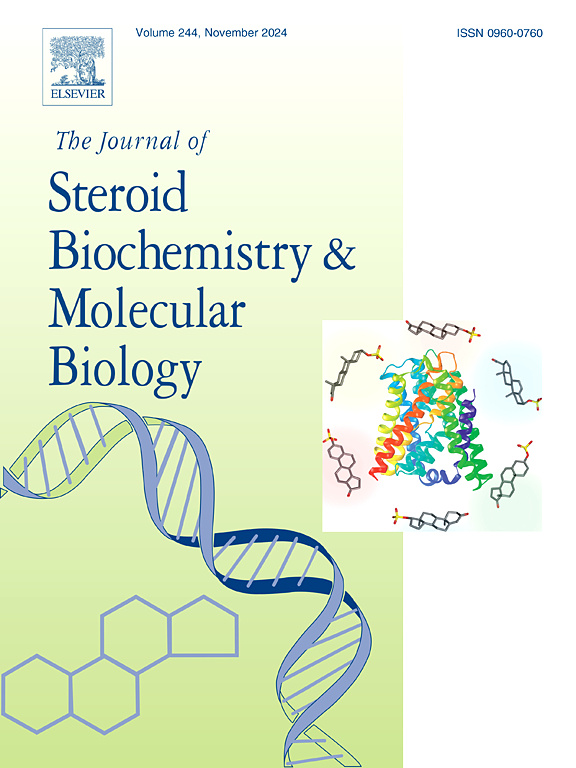铜纳米颗粒(CuNPs)对雄性小鼠下丘脑GnRH和垂体促性腺激素分泌的影响:一项免疫组织化学研究
IF 2.7
2区 生物学
Q3 BIOCHEMISTRY & MOLECULAR BIOLOGY
Journal of Steroid Biochemistry and Molecular Biology
Pub Date : 2025-02-13
DOI:10.1016/j.jsbmb.2025.106700
引用次数: 0
摘要
铜纳米颗粒在人类福利领域有着广泛的应用。尽管它的用途是有益的,但根据其大小、剂量和持续时间的不同,已知CuNPs会对各种器官造成毒性。男性和女性的生殖功能都受到CuNPs毒性的损害。本研究的目的是探讨长时间服用CuNPs对雄性小鼠下丘脑和垂体的影响与生殖神经内分泌调节的关系。因此,小鼠连续70天口服三种剂量(10,100和200 mg/kg)的CuNPs,以观察其不良反应。在CuNPs治疗组中,循环GnRH水平及其在中隆起的丰度没有改变。然而,在所有CuNPs治疗组中,循环FSH均显著下降,而LH仅在较高剂量的CuNPs治疗组中下降。垂体中黄体生成素和卵泡刺激素的免疫定位也显示丰度下降。因此,脑垂体功能受到严重影响;垂体前叶的结构也显示出变性的迹象,如空泡的存在,并且还表明,通过MDA染色,CuNPs处理组具有更高水平的MDA,这是一种氧化应激标志物。此外,GnRHR和AR的丰度在高剂量组的垂体中表现出较少的丰度。因此,我们可以得出结论,垂体对下丘脑GnRH和性腺类固醇的反应减弱,这可能是CuNPs处理小鼠促性腺激素抑制的原因。本文章由计算机程序翻译,如有差异,请以英文原文为准。
Impact of copper nanoparticles (CuNPs) on hypothalamic GnRH and pituitary gonadotropins secretions in a male mouse: An immunohistochemical study
The copper nanoparticles (CuNPs) have widely been used for human welfare in the various applications. Despite its uses for beneficial purposes, CuNPs has been known to cause toxicity in the various organ based on the size, dose and duration. Both male and female reproductive functions have been to be compromised under CuNPs toxicity. The aim of this study is to investigate the effects of CuNPs after prolonged duration on the hypothalamus and pituitary in relation to the neuroendocrine regulation of reproduction in male mice since it has not been done before. Due to which the mice were orally treated with three doses of CuNPs viz. 10,100 and 200 mg/kg for 70 consecutive days to examines its adverse effects. The circulating GnRH levels and its abundance in the median eminence did not change in the CuNPs treated groups. However, circulating FSH showed significant decline in all the CuNPs treated groups, while LH was decline only in higher doses of CuNPs. The immunolocalization of LH and FSH also showed decreased abundance in the pituitary. Thus, pituitary function showed severely affected by CuNPs; the architecture of anterior pituitary also showed sign of degeneration such a presence of vacuoles and it was also shown that CuNPs treated groups have higher level of MDA which is an oxidative stress marker as indicated by the MDA staining. Moreover, the abundance of GnRHR and AR exhibited less abundance in the pituitary of higher dose of CuNPs treated groups. Thus, it can be concluded that pituitary becomes less responsive for hypothalamic GnRH and gonadal steroid, which could be reason of suppressed gonadotropin in the CuNPs treated mice.
求助全文
通过发布文献求助,成功后即可免费获取论文全文。
去求助
来源期刊
CiteScore
8.60
自引率
2.40%
发文量
113
审稿时长
46 days
期刊介绍:
The Journal of Steroid Biochemistry and Molecular Biology is devoted to new experimental and theoretical developments in areas related to steroids including vitamin D, lipids and their metabolomics. The Journal publishes a variety of contributions, including original articles, general and focused reviews, and rapid communications (brief articles of particular interest and clear novelty). Selected cutting-edge topics will be addressed in Special Issues managed by Guest Editors. Special Issues will contain both commissioned reviews and original research papers to provide comprehensive coverage of specific topics, and all submissions will undergo rigorous peer-review prior to publication.

 求助内容:
求助内容: 应助结果提醒方式:
应助结果提醒方式:


